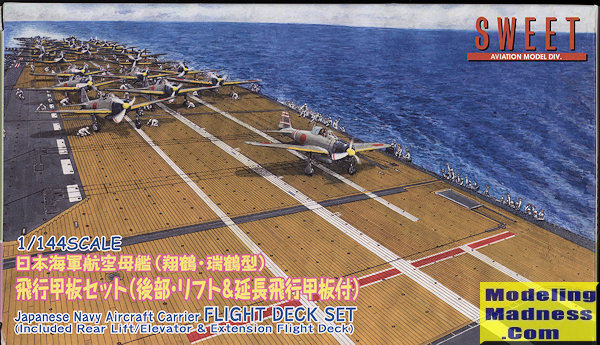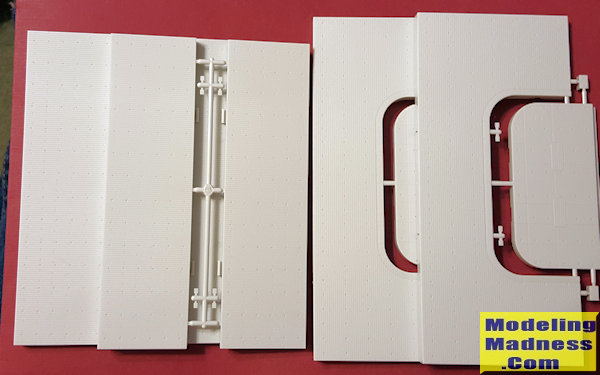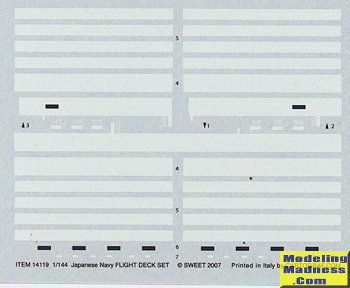
Sweet 1/144 Japanese Aircraft Carrier Flight Deck
| KIT #: | 14119 |
| PRICE: | 800 yen (about $7.00) from www.hlj.com |
| DECALS: | Deck Markings |
| REVIEWER: | Scott Van Aken |
| NOTES: | Two sets in one |

| HISTORY |
Today, aircraft carriers have steel flight decks. This is as much to do with being able to handle the weight of modern aircraft as well as the stress of them crashing down on them during landing and the heat of the steam catapults and jet blast during take off.
Carrier decks were not always metal, and it was the British who first armored their flight decks in the late 1930s, though above that armor was wood. Wood has the benefit of being a bit more flexible than steel and if a section is damaged, it is pretty easy to repair. It also is lighter than steel so keeps the ship from being too topheavy. Another benefit is that when planes crash on the deck, it does a bit less damage to the aircraft.
The down side is that it requires greater maintenance than metal, will burn, and offers little protection from bombs and naval artillery shells when the ship comes under fire. However, from the beginning of the type in through WWII, both the Americans and the Japanese carriers had wooden flight decks.
| THE KIT |
 This set is a combination of two kits. One is a standard flight deck section that comes in four sections. These are to be attached at the long side to make a 6 x 6 inch square section. This is large enough to display several aircraft. The other section includes the central elevator. This is two pieces that together measure 6 inches across and 7 inches long. The elevator section is separate and slightly shallower so you could pose it either just starting to lower or nearly coming fully up. The instructions show three of the first set pieces being attached to the 'back' as these elevators were generally near the front of the ship and one section in front.
This set is a combination of two kits. One is a standard flight deck section that comes in four sections. These are to be attached at the long side to make a 6 x 6 inch square section. This is large enough to display several aircraft. The other section includes the central elevator. This is two pieces that together measure 6 inches across and 7 inches long. The elevator section is separate and slightly shallower so you could pose it either just starting to lower or nearly coming fully up. The instructions show three of the first set pieces being attached to the 'back' as these elevators were generally near the front of the ship and one section in front.
Included in each set are several sets of wheel chocks as these planes were chocked on deck prior to take off to keep them from accidentally rolling onto the plane in front or behind it. The fore and aft sections are not clipped together, but the flat, square faces can easily be glued together.
 There is a full set of instructions in Japanese, so figuring out the colors from the instructions will be difficult. However, the two faces of the kit box provide a lot of assistance in this area. Unlike US flight decks of the time, Japanese decks were not painted. However, the various metal hatches and the metal elevator were. The kit offers a full set of deck markings as well, so it will not be bland at all. Those wanting even more could easily add more standard sections fore and aft. A diagram is also provided for those who wish to paint these deck stripes. The decal sheet is nicely printed by Cartograf so should work just fine.
There is a full set of instructions in Japanese, so figuring out the colors from the instructions will be difficult. However, the two faces of the kit box provide a lot of assistance in this area. Unlike US flight decks of the time, Japanese decks were not painted. However, the various metal hatches and the metal elevator were. The kit offers a full set of deck markings as well, so it will not be bland at all. Those wanting even more could easily add more standard sections fore and aft. A diagram is also provided for those who wish to paint these deck stripes. The decal sheet is nicely printed by Cartograf so should work just fine.
| CONCLUSIONS |
In all, it is a great kit and perfect for those who are into 1/144 Japanese carrier borne fighters and bombers. Hopefully Sweet will continue to expand its selection of kit in this area to include Val, Kate, and other carrier borne planes.
March 2016
Copyright ModelingMadness.com Thanks to www.hlj.com for the preview kit. You can get yours today at this link. If you would like your product reviewed fairly and fairly quickly, please contactthe editor or see other details in the